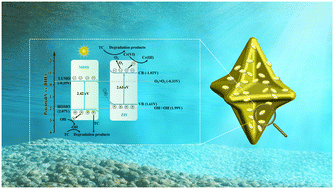Simultaneously enhanced photocatalytic cleanup of Cr(vi) and tetracycline via a ZnIn2S4 nanoflake-decorated 24-faceted concave MIL-88B(Fe) polyhedron S-scheme system†
Abstract
The coexistence of heavy metals and antibiotics in modern wastewater has caused unprecedented challenges for the simultaneous elimination of these contaminants, resulting in the urgent demand for developing highly-efficient photocatalysts. Herein, we devised and fabricated MIL-88B(Fe)@ZnIn2S4 (M88B@ZIS) S-scheme heterojunction photocatalysts via attaching ZnIn2S4 (ZIS) nanoflakes onto the surface of 24-faceted concave MIL-88B(Fe) (M88B) polyhedra, in situ. For a single pollutant system, all the M88B@ZIS hybrids exhibit obviously enhanced photocatalytic activities for Cr(VI) or tetracycline (TC) removal compared with M88B and ZIS alone. The optimal M88B@ZIS hybrid (M88B@ZIS-10) exhibits the best photocatalytic activities with 55.46% of Cr(VI) reduced and 73.14% of TC degraded singly after 80 min of reaction. More significantly, in a blended system of Cr(VI) and TC, the photocatalytic activities for reducing Cr(VI) and eliminating TC of M88B@ZIS-10 can be further improved to 92.46% and 87.14%, respectively, better than those of most of the reported photocatalysts. The corresponding reaction rate constants are 0.03249 min−1 and 0.02663 min−1, about 3.3 and 1.7-fold that in the single pollutant systems, respectively. The enhanced photocatalytic activities can be attributed to the following synergism: (1) the unique S-scheme heterostructures with an intimate contact interface accelerate the spatial separation and migration of the useful photoexcited electrons and holes with the stronger redox abilities; (2) the synergistic effects of concurrent Cr(VI) reduction and TC oxidative degradation from such a dual-function photocatalyst further improve the separation efficiency of the useful photoexcited charge carriers. Besides, the reaction pathway of TC degradation in the mixed system and the plausible S-scheme photocatalytic mechanism for synchronously removing Cr(VI) and TC over M88B@ZIS-10 are analysed in detail via the combined results of LC-MS, XPS, Fermi levels, capture tests of active species, ESR spectra, etc. Therefore, this work provides a profound understanding for constructing high-efficiency S-scheme heterojunction photocatalysts towards synchronously removing heavy metals and organic contaminants in effluents.

- This article is part of the themed collection: Environmental Remediation


 Please wait while we load your content...
Please wait while we load your content...